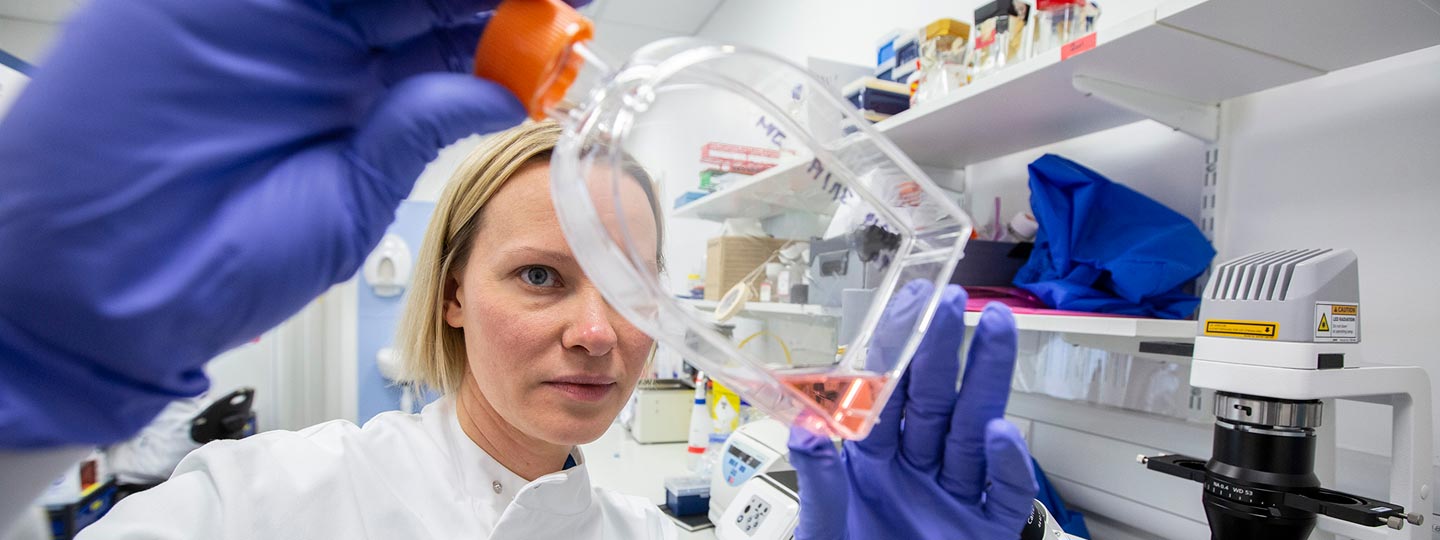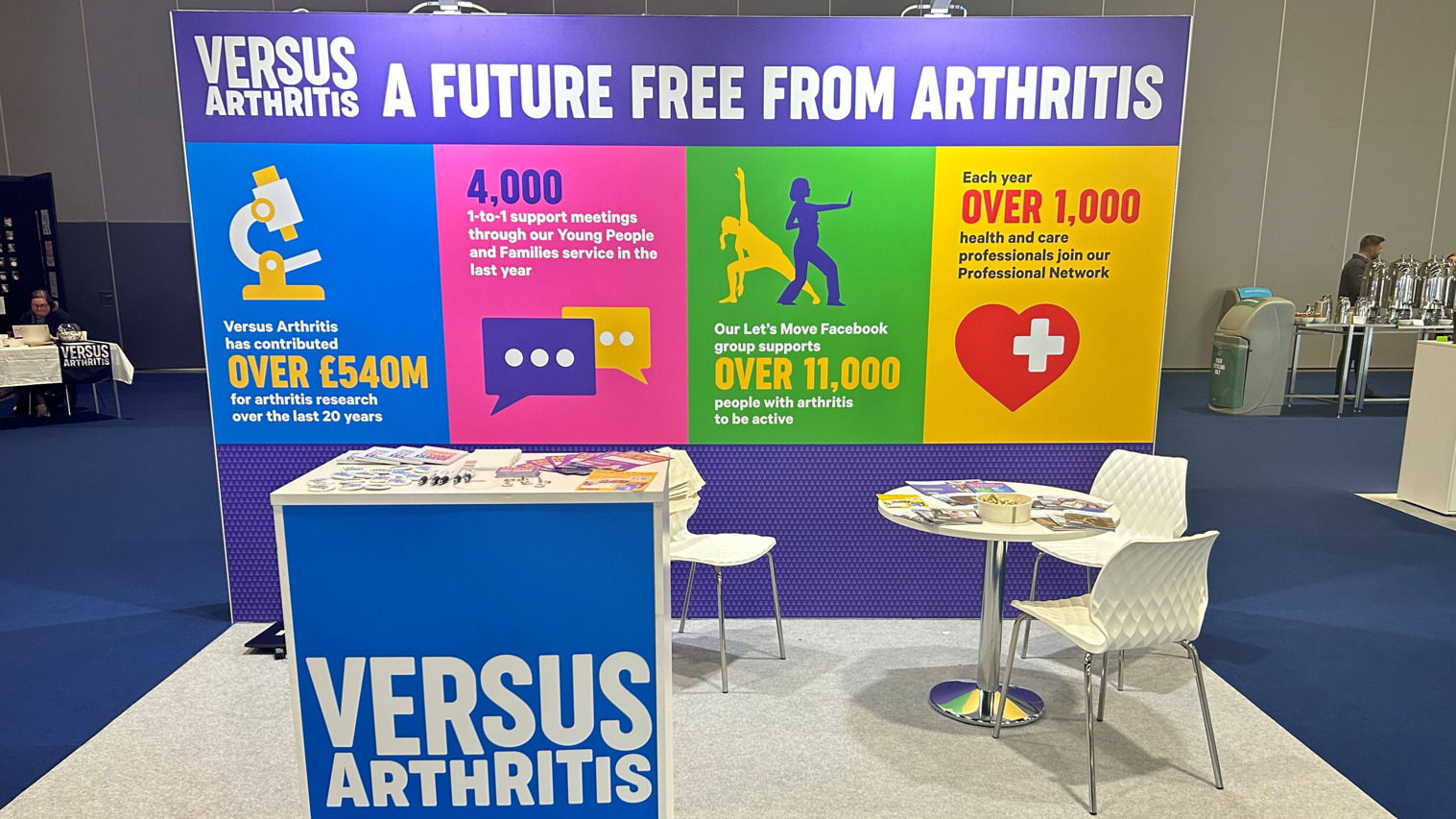Our highlights from the British Society for Rheumatology Conference 2024
18 July 2024
Want to learn about cutting-edge science in the field of rheumatology? You’ve come to the right place!
The British Society for Rheumatology (BSR) annual conference showcases inspiring research and best approaches to clinical care from world experts.
Read on for some highlights we’ve picked out from the event.
The microbiome: bacterial friends and foes
We know the microbiome, or the bacteria and other microorganisms that live in our bodies, can influence the immune system in many ways. We now know that this relationship is important in arthritis. The microbiome can influence:
- Your risk of developing arthritis.
- How severe your disease or flare-ups could be.
- How someone with arthritis might respond to their medicine.
Research is hoping to fill the gap in our knowledge about the role of our microbiomes in arthritis.
We heard from Professor Claudia Mauri, who is researching whether “gut-leakiness” is contributing to rheumatoid arthritis.
Gut leakiness is where the barrier of the gut is disrupted thus allowing chemicals and bacteria to move from the lumen (the inner part of the gut) into the body, which contribute to autoimmunity.
In mice with rheumatoid arthritis, there are less bacteria that turn fibre in the diet into short-chain fatty acids SCFA. Short- chain fatty acids are an important source of fuel for the cells in our gut.
The researchers showed that giving a type of SCFA called butyrate to these mice helped reduce their arthritis symptoms.
They also showed that butyrate reduces these symptoms because it helps increase other types of bacteria that produce serotonin. This is a molecule that plays a role in protecting the cells that line our gut, stopping them from being leaky.
This means in mice with rheumatoid arthritis, changes in bacteria and the molecules they produce are the cause of gut leakiness. Balancing our gut microbiome to reduce gut leakiness might be a treatment option in the future.
Artificial intelligence in arthritis healthcare
Researchers are equipping healthcare professionals with new AI tools to help predict, treat and manage arthritis.

While programmes like Chat-GPT wouldn’t be suitable replacements for a healthcare professional, healthcare professionals are increasingly using artificial intelligence as a tool in their work for many reasons.
One way that this technology could be used is through the creation of ‘prediction models’. Researchers are able to collect large datasets to make computer programmes that can predict ways in which a condition is likely to progress.
A patient’s data can then be put into the programme and generate different predictions.
Some highlighted research that has used AI for this purpose has been answering questions such as:
- How well might someone respond to a medicine and how do their symptoms change as a result? For example, researchers have used AI to predict whether a person will respond better to either of the two biologic medicines, rituximab or tocilizumab.
- Who is at high risk of developing a certain disease? For example, an algorithm analysing bone scans in osteoporosis patients could predict early symptoms of this condition.
The results from studies doing this have been mixed so far, but initial successes are promising.
AI could also be successful in helping healthcare professionals support their patients. Clinical Support Systems are AI programmes that can give tailored support advice for individuals based on their needs. Researchers have found healthcare professionals changed their decision-making based on AI recommendations too.

Long term outcomes for people with childhood onset autoimmune conditions
Juvenile or adult arthritis? How to effectively move care from paediatric to adult rheumatology
In the UK, childhood arthritis is usually well managed once a person is referred to a rheumatologist. Around a third of juvenile idiopathic arthritis (JIA) patients enter remission, where their disease is effectively controlled, before age 18. The rest continue to receive specialist care, as shown in this study.
Those that continue to receive this care as young adults will have to navigate the changes in how their disease is managed, which can prove challenging once they reach adulthood.
Using data from the NHS, and studies where we follow research participants over a period of time, researchers have identified key gaps:
- There is no defined way to move patients from paediatric to adult rheumatology.
- Because of this, these patients receive inconsistent care which can affect how their disease is managed.
Researchers suggest that this challenge must be prioritised. Helping young people move between child and adult health services is needed to remove the differences in care.
Read more about one of our researchers who is investigating this topic
Can we delay the onset of rheumatoid arthritis?
Clinical trial findings show that treatment with abatacept may delay the onset of rheumatoid arthritis in people at high risk of the disease.
Patients with a high risk of developing rheumatoid arthritis (RA) have increased levels of a molecule called anti-citrullinated peptide antibodies (ACPAs).
People with high levels of this molecule and minor arthritis symptoms are likely to develop RA within two years. A recent trial asked 213 people at risk of developing RA to take the medicine abatacept, to see if treating at-risk patients would delay the development of RA.
During the first year, 6% of those who had weekly abatacept injections developed RA, whereas 29% of those who didn’t get these injections (the placebo group) developed the disease.
12 months following treatment, 25% of the treatment group developed RA, compared to 37% of the placebo group.
Research has suggested that giving medicines that rebalance our immune system before someone develops RA can delay or even prevent the condition from developing. This could be revolutionary in preventing the pain and damage of arthritis before it begins. This study also lays the groundwork for similar studies to be carried out with other drugs to see if they may also prevent the development of RA and other inflammatory diseases.
It’s important to point out that as promising as these results are we need to be mindful that this treatment was effective in people that were identified to be at high risk of RA. This highlights the importance of ensuring that we can promptly diagnose people before there is irreversible damage to the joints.
Analysing the long-term outcomes in juvenile lupus
Lupus (SLE) is an autoimmune condition. This means the immune system, which is the body’s natural self-defence system, mistakenly attacks the body's own tissues.

There are two main types of lupus:
- discoid lupus.
- systemic lupus erythematosus (SLE).
Lupus can have many different symptoms, but the three most common are:
- joint pains.
- skin rashes, which may become noticeable after being out in the sun.
- extreme tiredness, known as fatigue.
Children with lupus are more likely to have symptoms that affect the kidneys and nervous system, whereas adults are more likely to have arthritis as the main symptom.
But how does childhood lupus progress into adulthood?
Long-term studies looking at how lupus progresses from childhood to adulthood showed some key features.
Firstly, how long you have the condition increases the risk of kidney problems developing, meaning younger people with lupus are more at risk.
Researchers are also looking at whether your risk of developing cardiovascular disease (CVD) increases if you have childhood lupus. CVD is a general term that describes a disease of the heart or blood vessels, such as strokes or coronary heart disease. As part of a heart health check, your doctor can calculate a cardiovascular disease risk score, which estimates your risk of having a heart attack or stroke in the next five years. But it's clear that further research is needed to make sure we understand how to monitor and identify CVD risk in children and young people with lupus.